
 |
|
|
#1 |
|
Member
Join Date: Mar 2007
Posts: 65
|
My very first dha . Popular tradition has it that you cannot unsheath a dha without bloodying it . This came without scabbard and is blunt anyway
 Comments please .  Full length view 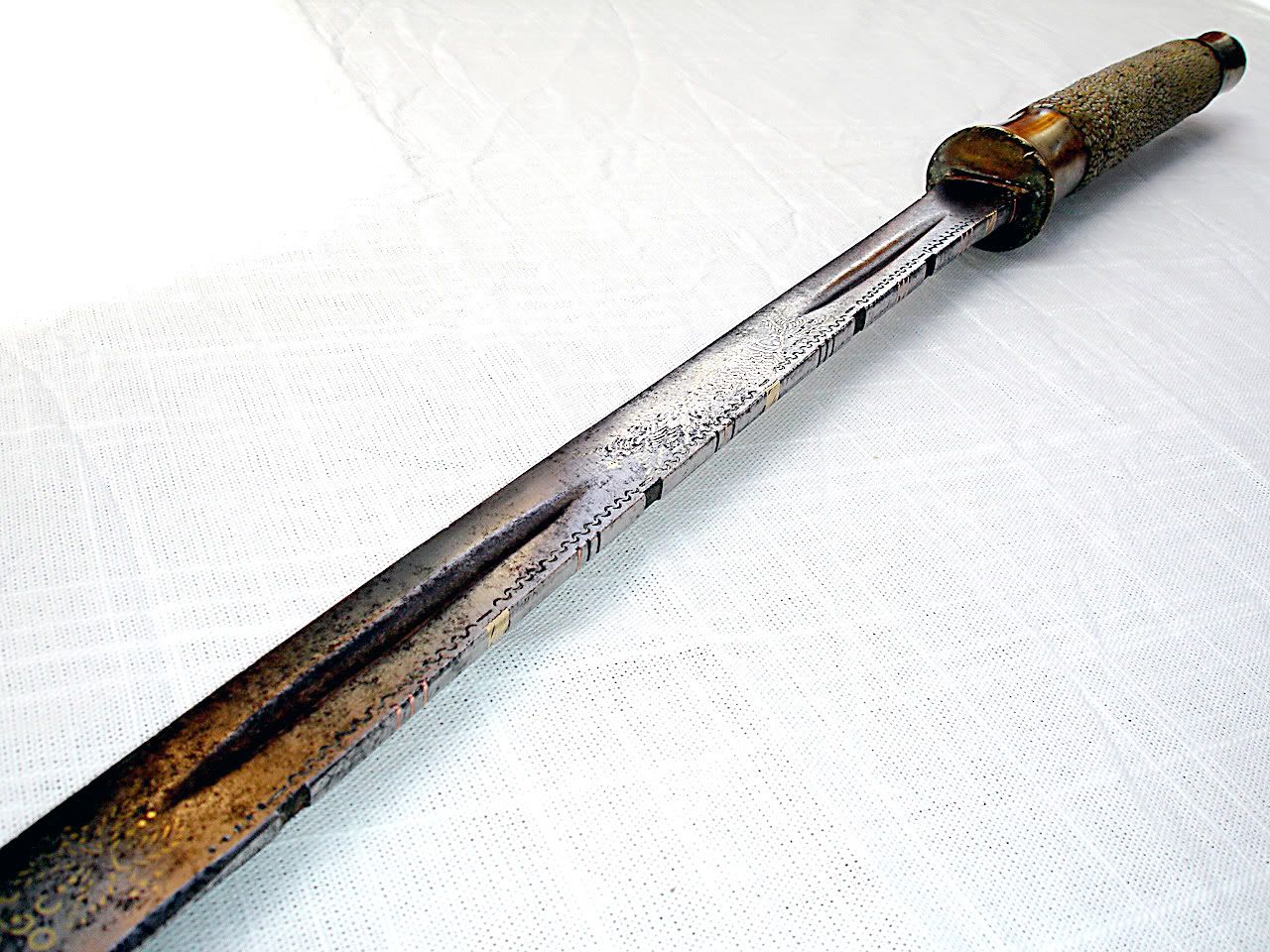 Overlay of fish pattern and writing in Burmese script |
|
|

|
|
|
#2 |
|
Member
Join Date: Dec 2004
Posts: 987
|
I really like this one. I just acquired a similar dha with the brass inlay decoration on the flat of the blade. It is not something you see too often. Another member has a matching dha-lwe and dha-hmyaung with this kind of decoration, but those are the only other ones I have seen.
I don't think that I have ever seen that kind of discontinuous fuller. One of Andrew's dha has a very long upswept time like this one, but that makes only two I have seen. A very nice and unusual dha. |
|
|

|
|
|
#3 |
|
Member
Join Date: Dec 2004
Location: Virginia
Posts: 520
|
A very nice dha, I have one that is similar but the fuller goes the entire way. I always thought it burmese maybe with an english influence ( no data on this just the feel of it) but someone here may know better I also have a dha-hmyaung with this type of koftgari. I will try to post pictures soon
|
|
|

|
|
|
#4 |
|
Member
Join Date: Mar 2007
Posts: 65
|
 Fish decoration 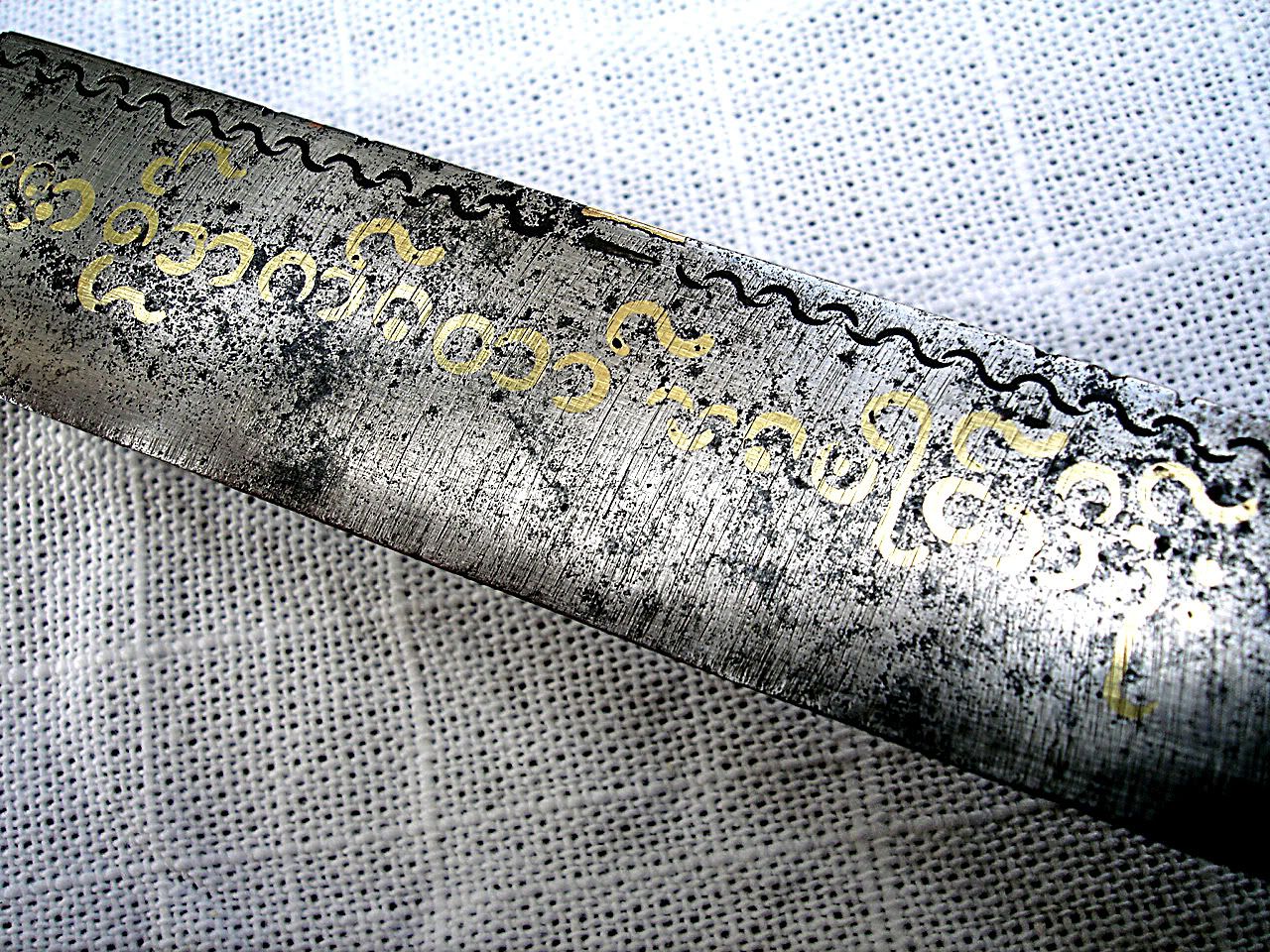 Ingabettaw Maung Thein 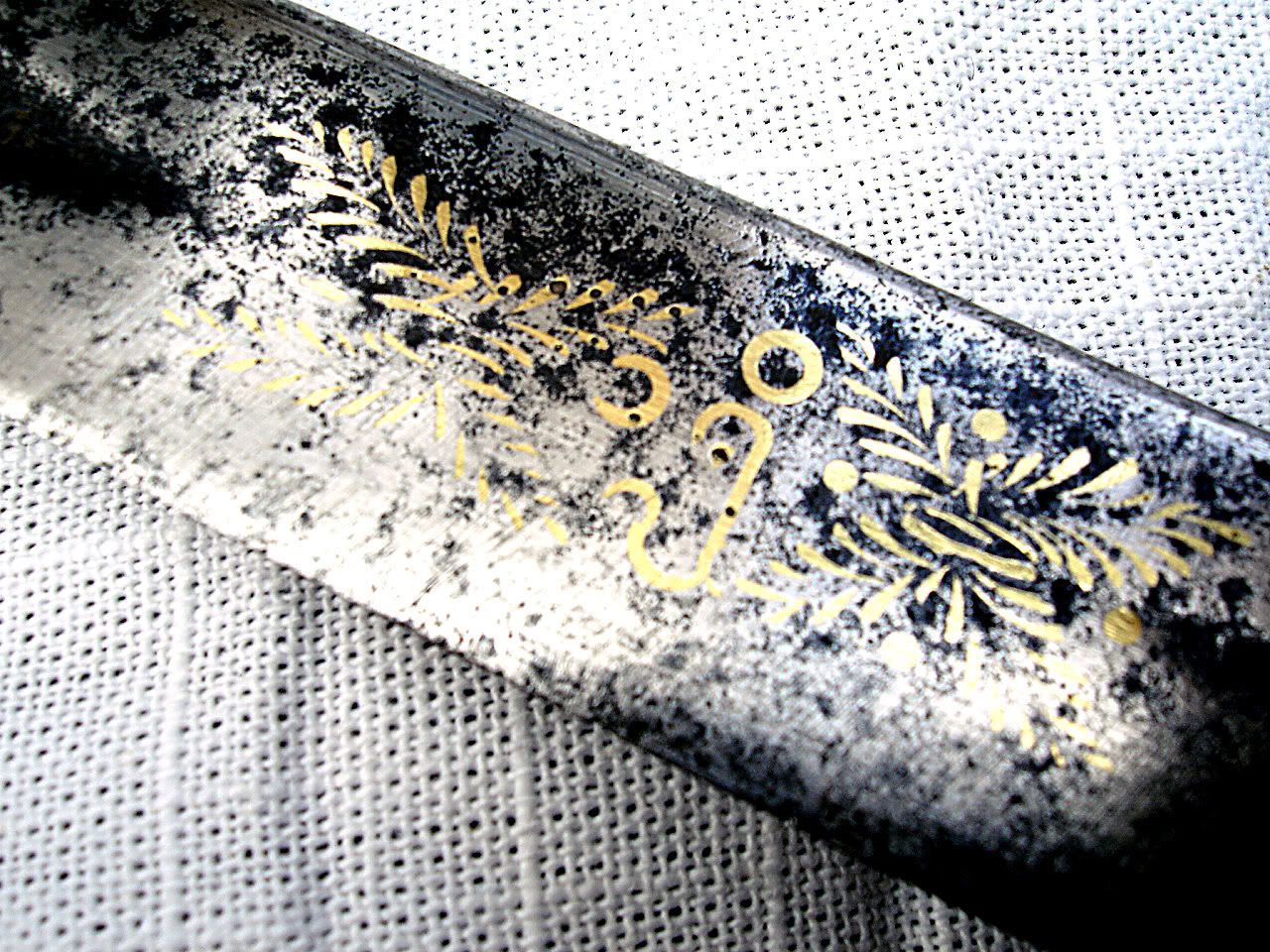 15 kyat ( kyat / chat = layer or also a unit of weight measurement : also used latterly for the currency post independence ) |
|
|

|
|
|
#5 |
|
Member
Join Date: Dec 2004
Location: Virginia
Posts: 520
|
  
|
|
|

|
|
|
#6 |
|
Member
Join Date: Nov 2004
Location: USA
Posts: 1,725
|
Very nice! I didn't really appreciate this when I last looked at it.
 The "interrupted" fuller is eye-catching, and I find this blade shape quite elegant and graceful. The inlay is beautiful and the text particularly crisp. Can you translate it? Mark, were you referring to the overall blade shape tapering to the tip? The date-inlaid (brass? gold?) pattern welded example I have is similar. |
|
|

|
|
|
#7 | |
|
Member
Join Date: Nov 2004
Location: USA
Posts: 1,725
|
Quote:
|
|
|
|

|
|
|
#8 |
|
Member
Join Date: Mar 2007
Posts: 65
|
( Let me know if I'm not allowed to do this )
This is from the gallery at Oriental Arms . The item was sold just last month. It is again similar with the brass inlay , a rayskin grip and a rather narrow point . Like John's it has a single fuller on each side but the shape is straighter like my example. ( I wonder if the curvature on John's has increased looking at the convexity of the brass inserts in the spine ? )    Does anyone know generally ( in other cultures / other sword types ) whether the markings on the spine are simply just decoration or have a meaning of some kind. A relative of mine ( who is not a dha expert  ) remembers from childhood that these notches related to use / kill / number of battles . ) remembers from childhood that these notches related to use / kill / number of battles .The writing on my item reads Inga-Bettaw Maung Thein . Inga-Bettaw sounds like a place name and Maung Thein is a person ( sword smith ? ) . The numbers read 15 with the kyat symbol ( which looks like an o on both sides ) The symbolism is now used to denote the post colonial currency but I think in previous times could have been exclusively a measure of weight or the number of layers : kyat roughly translates as layer ( the term kyat is still used today as a measure as well as the currency ) . The sword is very well balanced and has seen considerable use with several notches along the blade and some deeper cuts in the ferrule . The proximal third of the blade has been much sharpened and has lost some of its width as a result . I questioned the age but was advised that it must be at least 1900 as it shares unusual stylistic similarities with a sword belonging to the Oldman collection. It seems to be a genuine fighting dha rather than a presentation piece . ( John , Do you have a photo of the matching dha-hmyaung ? ) 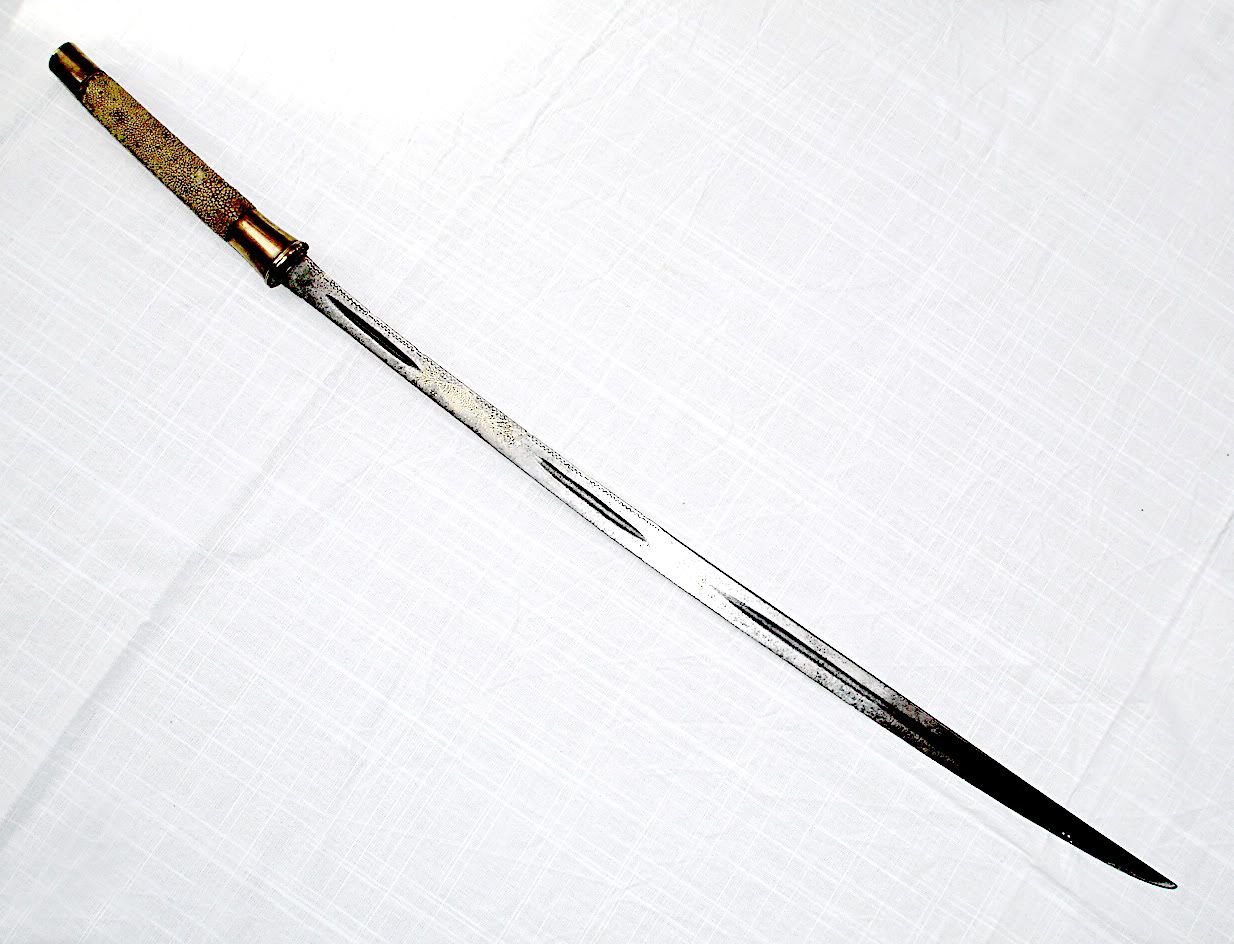 Another view Last edited by ~Alaung_Hpaya~; 3rd April 2007 at 03:07 PM. |
|
|

|
|
|
#9 |
|
Member
Join Date: Dec 2004
Posts: 987
|
Andrew - yes, I was refering the the damascus dha with the date cartouche, which I expect is the "Oldman" dha refered to.
Alaung Hpaya - Artzi (Oriental Arms) doesn't mind linking to his photos. I was going to do the same, as that is the inlaid dha I was talking about that I bought at Timonium. We haven't found any clear information on the brass, and sometimes copper, insets along the spine. I sort of doubt that it counts kills, since I think its something that would have been done at the time of manufacture, and the patterns are always very regular, which should not be the case unless the owner always killed in even numbers  . I have found reference to the talismanic significance of some metals in Burmese and Thai culture, but not specifically brass or copper. It is something that I have most often seen on Shan and Thai dha, in the latter case in the more contemporary krabi-krabong daab. . I have found reference to the talismanic significance of some metals in Burmese and Thai culture, but not specifically brass or copper. It is something that I have most often seen on Shan and Thai dha, in the latter case in the more contemporary krabi-krabong daab.Philip Tom has suggested that it is a stylized representation of bamboo. Kyat being reference to the number of layers is interesting, but wouldn't one expect the number to be either smaller (welded billet) or even (folded billet)? Could it refer to the weight of the sword? |
|
|

|
|
|
#10 |
|
Member
Join Date: Mar 2007
Posts: 65
|
I would guess kyat is likely to refer to the weight of the sword ( I'm not overly familiar with Burmese measurements but I think it refers to density more specifically than mass ) .
Here is a picture of the spine showing the regular lines : 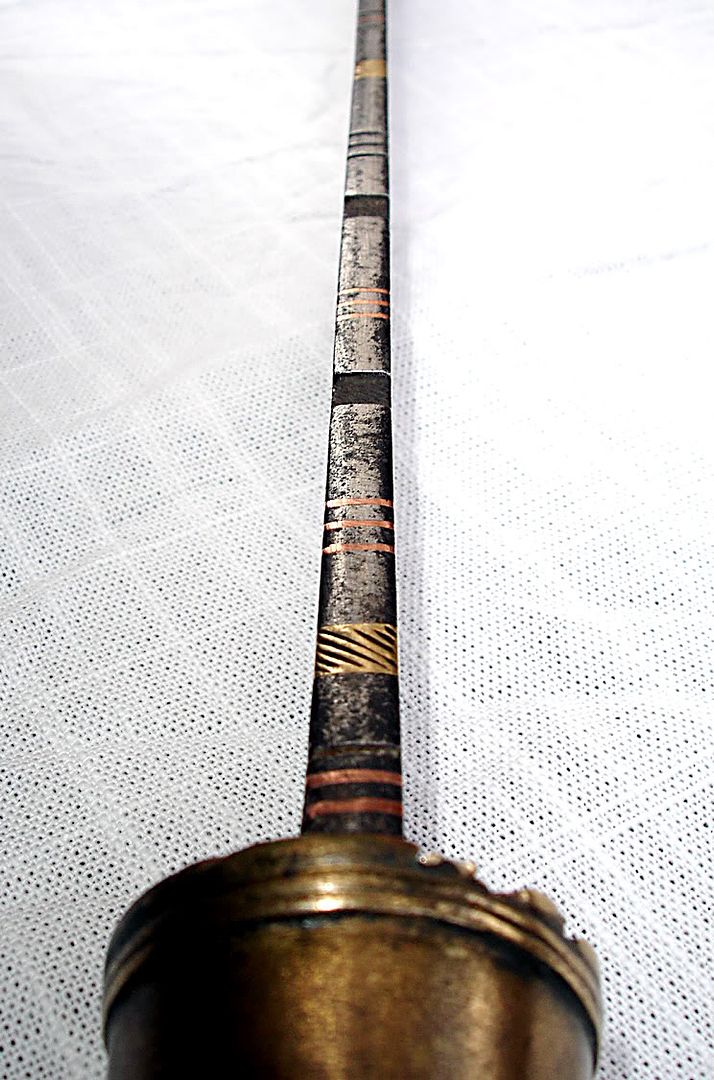 It looks like some of the brass and copper have fallen out . There are identical diagonal lines on the steel where there is no brass . Is this to allow purchase for the brass or a deliberate pattern and therefore a deliberate random variation in the design ? |
|
|

|
|
|
#11 |
|
Member
Join Date: Dec 2004
Posts: 987
|
I believe that the cross-hatching on the steel is to provide better attachment for the inset, so those would be areas were one has fallen out. If you look at the close-up in the second photo of my sword, you can see the inset edge-on, and how it is attached to the steel below.
|
|
|

|
|
|
#12 |
|
Member
Join Date: Dec 2004
Location: Virginia
Posts: 520
|
We have talked before that these markings on the spine. If I remember correctly they are also found on malay klewangs, tenegre, talibon, parang nabur and more rarely chinese swords
I will post pictures of the dha-hmyaung soon |
|
|

|
|
|
#13 | |
|
Vikingsword Staff
Join Date: Dec 2004
Location: The Aussie Bush
Posts: 4,023
|
Hi John:
We have indeed discussed these inlaid areas and marks before. They appear also on a short Thai pole arm that can be seen here: http://www.vikingsword.com/vb/showthread.php?t=605 I believe PUFF had a very interesting observation a while back when he said that these marks were a type of "registration" for specific weapons and owners. In the past the marks on the spine were recorded against the name of the owner, but more modern pieces simply use these as decoration: http://www.vikingsword.com/vb/showthread.php?t=3021 Quote:
Last edited by Ian; 4th April 2007 at 03:24 AM. |
|
|
|

|
 |
|
|